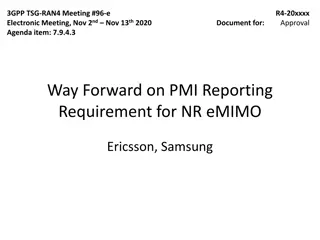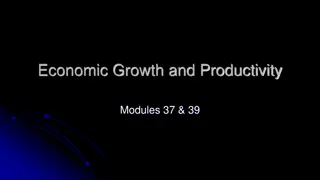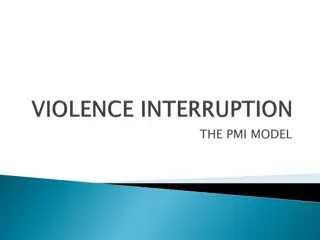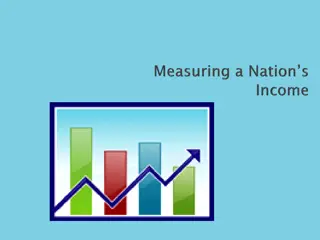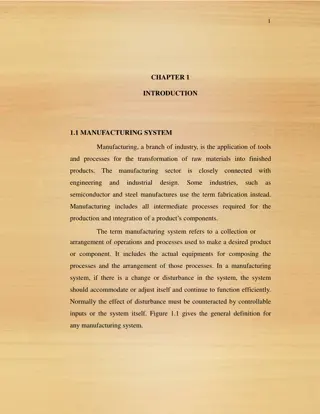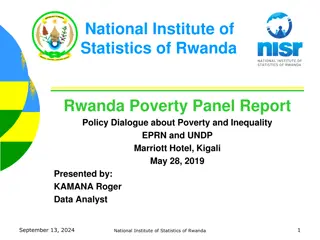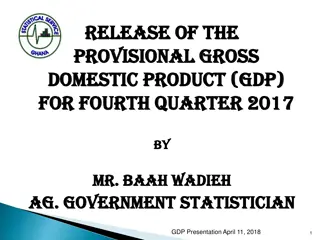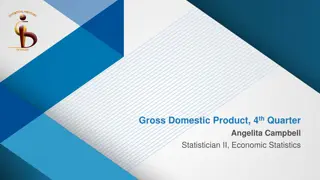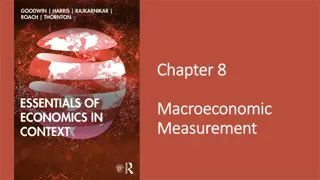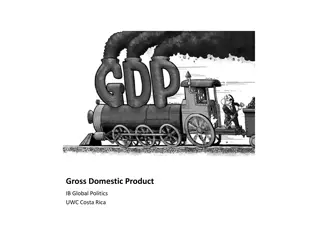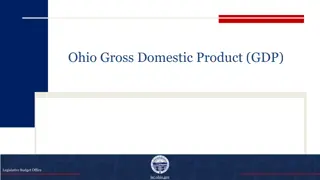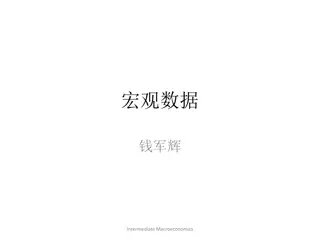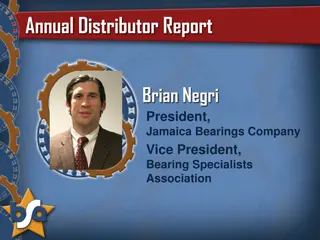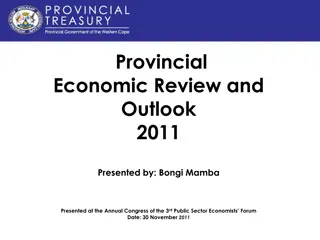Global Economic Overview: GDP Growth, Manufacturing PMI, and Equity Market Movements
The data presented covers real GDP growth by region and country for 2014 and 2015, manufacturing PMI trends in the Eurozone, USA, and China, as well as movements in global equity markets up to March 2016. Additionally, it includes forecasts for real GDP growth globally and by economic sector, providing insights into the economic performance of various countries and regions.
Download Presentation

Please find below an Image/Link to download the presentation.
The content on the website is provided AS IS for your information and personal use only. It may not be sold, licensed, or shared on other websites without obtaining consent from the author.If you encounter any issues during the download, it is possible that the publisher has removed the file from their server.
You are allowed to download the files provided on this website for personal or commercial use, subject to the condition that they are used lawfully. All files are the property of their respective owners.
The content on the website is provided AS IS for your information and personal use only. It may not be sold, licensed, or shared on other websites without obtaining consent from the author.
E N D
Presentation Transcript
Real GDP growth by region and country in 2014 and 2015 2015 3.1 World 3.4 2014 1.9 Advanced economies 1.8 4.0 Developing economies 4.6 2.5 USA 2.4 1.5 Eurozone 0.9 1.5 Germany 1.6 1.1 France 0.2 0.8 Italy -0.4 3.2 Spain 1.4 0.6 Japan 0.0 -3.8 Brazil 0.1 -3.7 Russia 0.6 7.3 India 7.3 6.9 China 7.3 1.3 South Africa 1.5 -4.0 -2.0 0.0 2.0 4.0 6.0 8.0 % Change (y-o-y) Source: IDC, compiled from IMF data 3
Eurozone manufacturing PMI trend Eurozone manufacturing PMI trend USA manufacturing PMI USA manufacturing PMI 65 70 60 60 55 50 50 Index Index 45 40 40 30 35 30 20 1 3 5 7 9111 3 5 7 9111 3 5 7 9111 3 5 7 9111 3 5 7 9111 3 5 7 9111 3 5 7 9111 3 5 7 9111 3 5 7 9111 1 3 5 7 9111 3 5 7 9111 3 5 7 9111 3 5 7 9111 3 5 7 9111 3 5 7 9111 3 5 7 9111 3 5 7 9111 3 5 7 9111 | 2007 | 2008 | 2009 | 2010 | 2011 | 2012 | 2013 | 2014 | 2015 | | 2007 | 2008 | 2009 | 2010 | 2011 | 2012 | 2013 | 2014 | 2015 | Source: IDC, compiled from Bloomberg data Source: IDC, compiled from Bloomberg data China manufacturing PMI China manufacturing PMI 60 55 50 Index 45 40 35 1 3 5 7 9111 3 5 7 9111 3 5 7 9111 3 5 7 9111 3 5 7 9111 3 5 7 9111 3 5 7 9111 3 5 7 9111 3 5 7 9111 | 2007 | 2008 | 2009 | 2010 | 2011 | 2012 | 2013 | 2014 | 2015 | 4 Source: IDC, compiled from Bloomberg data
Movements in global equity markets from their most recent high up to 8 March 2016 UK: -13.0% Germany: -21.0% US DJIA: -6.8% France: -15.7% US S&P: -6.1% Japan: -19% China: -43.9% Hong Kong: -29.1% Malaysia: -10.3% Brazil: -20.4% Bear markets SA: -4.6% Australia: -11.5% Corrections 5
Real GDP growth around the globe 10 Forecast 8 6 % Change (y-o-y) 4 2 0 -2 -4 World Advanced economies Emerging market and developing economies -6 Source: IDC, compiled from IMF data 6
Real GDP growth according to main economic sector 6 4 2 % Change (y-o-y) 0 -2 -4 -6 2010 2011 2012 2013 2014 2015 -8 Agricul- ture (2.3%) Mining (8%) Manufac- turing (13%) Electri- city (3.6%) Construc- tion (4%) Trade & accom. (15%) Trans- port & communi- cation (10%) Finance & business services (20.9%) Govern- ment services (17.4%) Personal services (5.7%) Total GDP Source: IDC, compiled from Stats SA data 9
Growth in manufacturing volume of production Growth in manufacturing volume of production 6 4 2 % Change (y-o-y) 0 -2 -4 -13.8% -6 2000 2001 2002 2003 2004 2005 2006 2007 2008 2009 2010 2011 2012 2013 2014 2015 Source: IDC, compiled from Stats SA data 10
Manufacturing sector contribution to GDP Manufacturing sector contribution to GDP 26 24 22 20 Percentage 18 16 14 12 10 1960 1965 1970 1975 1980 1985 1990 1995 2000 2005 2010 2015 Source: IDC, compiled from SARB data 11
Fixed investment by the manufacturing sector Fixed investment by the manufacturing sector Manufacturing volume of production Manufacturing volume of production 20 125 120 S 10 115 Index: 2010 = 100 0 110 % Change (y-o-y) 105 -10 100 95 -20 90 -30 85 80 -40 1998 1999 2000 2001 2002 2003 2004 2005 2006 2007 2008 2009 2010 2011 2012 2013 2014 2015 2000 2001 2002 2003 2004 2005 2006 2007 2008 2009 2010 2011 2012 2013 2014 2015 (Q1 - Q3) Source: IDC, compiled from Stats SA data Source: IDC, compiled from SARB data Manufacturing employment trend Manufacturing employment trend Manufacturing: Expected business conditions in 12 months' time 100 Manufacturing total Paper 50 Furniture Beverages Change in number (y-o-y) 0 Basic metals Non-metallic minerals Food -50 Chemicals Transport equipment -100 Fabricated metals Printing & publishing Machinery -150 Wood Clothing -200 Plastics Survey results of Q4 of 2015 Textiles Electrical machinery -250 Q1 Q2 Q3 Q4 Q1 Q2 Q3 Q4 Q1 Q2 Q3 Q4 Q1 Q2 Q3 Q4 Q1 Q2 Q3 Q4 Q1 Q2 Q3 Q4 Q1 Q2 Q3 Q4 -100 -80 -60 -40 -20 Net balance 0 20 40 60 80 2009 | 2010 | 2011 | 2012 | 2013 | 2014 | 2015 | 12 12 Source: IDC, compiledfrom Stats SA data Source: IDC, compiled from BER data
Indirect impact GDP = R44.2 bn Jobs = 107 280 Chemical sector in 2014 GDP = R46.8 bn Employment = 77 339 Economy-wide impact across all sectors of SA economy First round impact GDP = R51.9 bn Jobs = 137 590 GDP = R221.0 bn Jobs = 540 476 Induced impact GDP = R78.2 bn Jobs = 218 267 14
Export propensity of the chemicals sector Import penetration of the chemicals sector 45 50 45 40 Imports as % of Domestic demand 40 35 Exports as % of Output 35 30 30 25 25 20 20 15 15 10 10 5 5 0 0 1994 1996 1998 2000 2002 2004 2006 2008 2010 2012 2014 1994 1996 1998 2000 2002 2004 2006 2008 2010 2012 2014 Source: IDC, compiled from Quantec data Source: IDC, compiled from Quantec data 17
Growth in volume of production Growth in volume of production 25 Basic chemicals Other chemicals 20 15 % Change (y-o-y) 10 5 0 -5 -10 -29% -15 2000 2001 2002 2003 2004 2005 2006 2007 2008 2009 2010 2011 2012 2013 2014 2015 Source: IDC, compiled from Stats SA data 18
Constraints on business activity in the chemical sector in Q4 2015 Insufficient demand Political climate (policy issues) Interest rates Raw materials Skilled labour Semi-skilled Unskilled labour 0 20 40 60 80 Percentage Source: IDC, compiled from BER data 19
South Africa's trade balance according to broad sector 300 200 100 Rand Billion 0 -100 Mining -200 Other (incl. electricity) Agriculture -300 Manufacturing Overall trade balance -400 Source: IDC, compiled from SARS data 20
Key manufacturing export products in 2014 and 2015 20 18 2014 2015 % share in export basket 16 14 12 10 8 6 4 2 0 Source: IDC, compiled from SARS data 21
South Africa's exports to the rest of Africa in 2015 as a % of total exports South Africa's exports to the rest of Africa in 2015 as a % of total exports Export value R10.4 bn R5.5 bn R11.9 bn R36.6 bn R69.8 bn R9.1 bn R62.0 bn Electrical machinery & apparatus 80.8 Other non-metallic mineral products 71.2 Textiles, clothing, footwear & leather goods 67.8 Food, beverages & tobacco 60.3 Petroleum, chemicals, rubber & plastic 55.3 TV, Radio, instruments, watches & clocks 55.1 Base metal products, machinery & equip. 38.3 R9.8 bn Wood, paper, publishing & printing 38.0 R7.5 bn R12.0 bn R30.9 bn R8.0 bn R10.0 bn Furniture & other manufacturing 23.1 Agriculture, forestry & fishing 22.7 Transport equipment 20.8 Coal mining 14.7 Other mining & quarrying 4.6 0 20 40 60 80 100 Percentage Source: IDC, compiled from SARS data 22
Export destinations of other chemicals Export destinations of basic chemicals SADC (excl. BLNS) 21.9% India 0.5% Singapore 0.6% SADC (excl. BLNS) 26.3% China 1.6% Other 17.7% Other 12.2% Singapore 4.2% Japan 1.0% India 3.8% USA 4.4% BLNS 7.1% China 3.0% Africa (other) 7.1% EU 14.5% Japan 1.3% Africa (other) 10.5% USA 16.6% BLNS 28.5% EU 17.4% 23
Employment trend Employment trend 140 Total employment Private sector 130 Community and social services Manufacturing 120 Index: 2008 Q1 = 100 110 100 90 80 70 Q1 Q2 Q3 Q4 Q1 Q2 Q3 Q4 Q1 Q2 Q3 Q4 Q1 Q2 Q3 Q4 Q1 Q2 Q3 Q4 Q1 Q2 Q3 Q4 Q1 Q2 Q3 Q4 Q1 Q2 Q3 Q4 2008 | 2009 | 2010 | 2011 | 2012 | 2013 | 2014 | 2015 | Source: IDC, compiledfrom Stats SA data 24
Consumer price inflation Consumer price inflation 20 CPI : Targeted inflation 18 Food 16 14 % Change (y-o-y) 12 10 8 6 Inflation target band 4 2 0 1 35 7 9111 35 7 9111 35 7 9111 35 7 9111 35 7 9111 35 7 9111 35 7 9111 35 7 9111 35 7 9111 35 7 9111 | 2006 | 2007 | 2008 | 2009 | 2010 | 2011 | 2012 | 2013 | 2014 | 2015 | Source: IDC, compiledfrom Stats SA data 25
Business confidence in the SA economy and in the manufacturing sector 90 SA economy Extreme confidence 80 Manufacturing 70 60 Net balance 50 Neutral 40 30 20 10 Extreme lack of confidence 0 Q1 Q3 2007 Q1 Q3 2008 Q1 Q3 2009 Q1 Q3 2010 Q1 Q3 2011 Q1 Q3 2012 Q1 Q3 2013 Q1 Q3 2014 Q1 Q3 2015 Source: IDC, compiledfrom BERdata 26
The leading business cycle indicator and the PMI The leading business cycle indicator and the PMI 110 70 PMI (Rhs) 105 65 Leading indicator (Lhs) 100 60 Index: 2010 = 100 95 55 PMI - Index 90 50 85 45 80 40 75 35 70 30 1 357 9111 357 9111 357 9111 357 9111 357 9111 357 9111 357 9111 357 9111 357 9111 357 9111 | 2006 | 2007 | 2008 | 2009 | 2010 | 2011 | 2012 | 2013 | 2014 | 2015 | Source: IDC, compiled from SARB & BER data 27
Household consumption expenditure 20 15 10 % Change (y-o-y) 5 0 -5 -10 Total spending -15 Durable goods -20 2006 2008 2010 2012 2014 2016f 2018f 2020f 28
Gross fixed capital formation (GFCF) 15 25 10 20 % Change (y-o-y) % of GDP 5 15 0 10 -5 5 GFCF (% growth) GFCF as % of GDP -10 0 2006 2008 2010 2012 2014 2016f 2018f 2020f 29
Growth in GDP and GDE 10 8 % Change (y-o-y) 6 4 2 0 -2 Gross domestic product (GDP) Gross domestic expenditure (GDE) -4 2006 2008 2010 2012 2014 2016f 2018f 2020f 30
Gerhard Kuhn Senior Economist Department of Research and Information Industrial Development Corporation of South Africa Limited P O Box 784055 SANDTON 2146 Tel : +27 11 269-3617 E-mail: gerhardk@idc.co.za E-mail: nicok@idc.co.za Nico Kelder Tel: +27 11 269 3385 31


